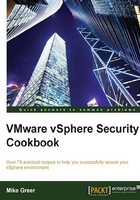
Physical threats
The topic of physical security might seem out of place in a book on virtual security; however, it plays a key role. As referenced in the defense-in-depth model, the most thorough design and implementation can be breached if physical security fails. For example, if one can physically access a console logged in with administrative credentials, security controls are effectively neutralized.
Physical threats by nature are threats that require physical access to the hardware in order to exploit the systems. In the case of virtualization hardware, the threat vector is somewhat lessened if you assume that the hardware will reside in some form of secure datacenter structure, be it a secure facility or room. In addition, carrying out administrative tasks on management desktops situated in secure locations without access to any public networks will also reduce risk.
Even with equipment residing in a secure facility, there are a number of threats that remain, including nonmalicious factors such as extreme weather and power outages. Other threat vectors include security and authentication mechanisms to the facility and within the facility to the server location. Typically, in a highly secure facility, a cage within the datacenter is used to secure the server hardware. Entry into the cage is limited to certain personnel and controlled by biometric or card reader devices.
Another potential threat is the personnel that staff the facility. A dishonest employee, even one who has been fully vetted and background-checked can gain access to sensitive equipment and potentially the data residing on that equipment. Alternatively, a dishonest employee can grant access to an outsider who is intending to attack a particular company's server or virtualization environment contained in the facility.